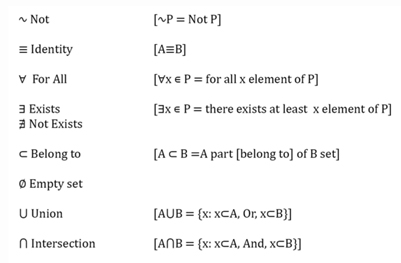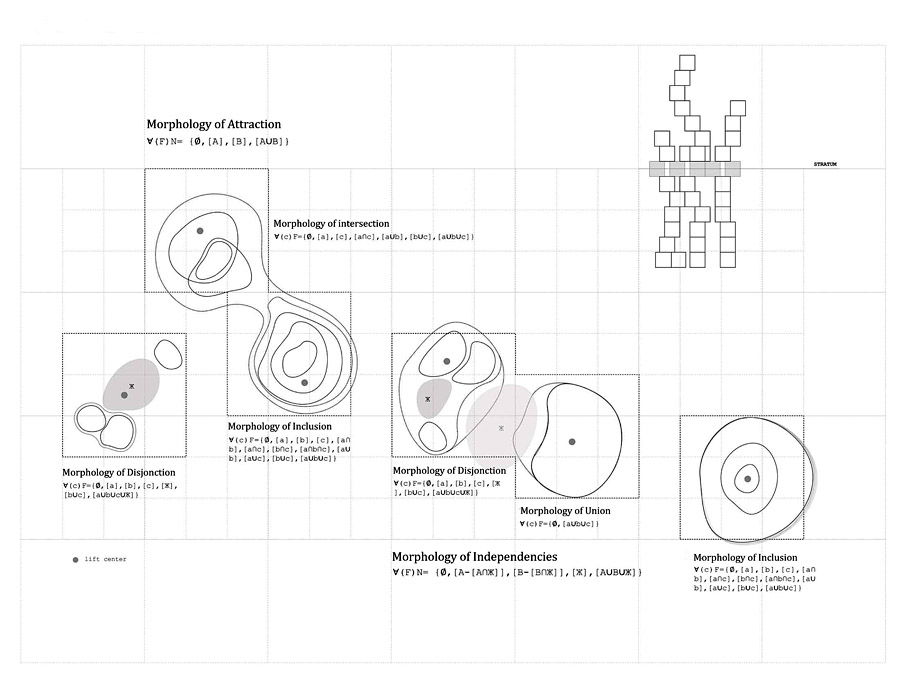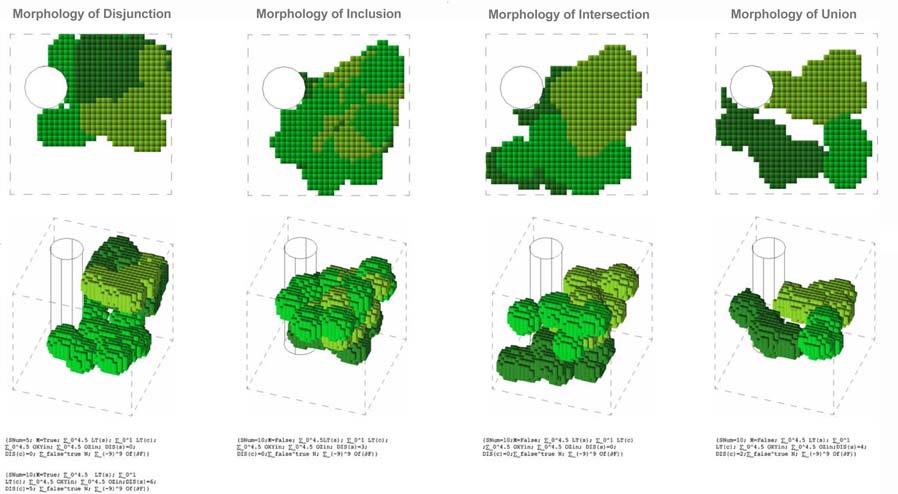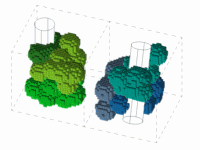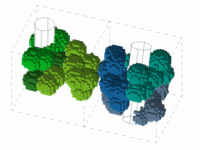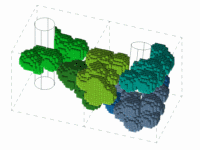Physiomorphologies / new-territories / francois Roche
From the physiology of “humeurs” to “malentendus“
The collection of “humeurs” is organized on the basis of interviews that make visible the conflict and even schizophrenia of desires, between those secreted (biochemical and neurobiological) and those expressed through the interface of language (free will). Mathematical tools taken from set theory (belonging, inclusion, intersection, difference, etc.) are used so that these “” malentendus ” ” produce morphological potential (attraction, exclusion, touching, repulsion, indifference, etc.) as a negotiation of “distances” between the human beings who are to constitute these collective aggregates.
“Les malentendus”
This means taking conflicts into account as an operational mode, allowing architecture to become their transactional vector.
“I’d love to but at the same time / and maybe / not / and the contrary.”
These ” malentendus ” are directly influenced by the pathologies of collective living:
Claustro (phobia-philia)
Agora (phobia-philia)
Xeno (phobia-philia)
Acro (phobia-philia)
Nocto (phobia-philia)
Socio (phobia-philia)
Neo (phobia-philia)…
From “Les malentendus ” of “humeurs” to physio-morphological computation
These relational modes are simultaneously elaborated within the residential cell and on its periphery in relation to the neighbors. The multiplicity of possible physio-morphological layouts based on mathematical formulations offers a variety of habitable patterns in terms of the transfer of the self to the Other and to others. This is an informational area, a Temporary Autonomous Zone (T.A.Z.) allowing future purchasers to have access to a morphological combinatorics with multiple permutations produced jointly by the expression of their avowed desires and their indiscrete biochemical secretions.
The volume of an entity-unit is 12 x 12 x 12 meters. This is the basis on which our calculations and hypotheses have been made.
“humeurs”
From the Latin umor: liquid / From the Greek thumos: the passions / In medicine: fluid contained in the organism. This fluid can be real, like blood, lymph and bile, or supposedly real, or even hypothetical, like black bile. / In psychology, the original thymic state governing the emotions and affect.
The four temperaments linked to the four “humeurs” (Hippocrates, 479-377 B.C.E.) Each humor corresponds to an element: phlegm corresponds to water / phlegmatic Blood corresponds to air / sanguine Yellow bile corresponds to fire / hot-tempered, bilious Black bile corresponds to the earth / melancholy (but also tense)
Bio-chemistry

Dopamine is a neurotransmitter, a member of the catecholamine family, and thus a product of the amino acid tyrosine / the pleasure molecule..
Adrenalin is hormone belonging to the catecholamine family. It is produced in response to a need for energy, for example to deal with a dangerous situation / the molecule of the ability to react.
Cortisol is a corticosteroid hormone or glucocorticoid produced by the zona fasciculata (middle zone) of the adrenal cortex, usually referred to as the “stress hormone” as it is involved in response to stress and anxiety, controlled by CRH (Corticotropin-Releasing Hormone)
Serotonin, also known as 5-hydroxy-tryptamine (5-HT), is a molecule produced from trytophan / the molecule of melancholy, “depression.”
Enkephalin is a pentapeptide involved in regulating nociception in the body. The enkephalins are termed endogenous ligands, or specifically endorphins, as they are internally derived and bind to the body’s opioid receptors. Enkephalins function as neurotransmitters or neuromodulators and inhibit neurotransmitters in the pathway for pain perception, thereby reducing the emotional as well as the physical impact of pain. Enkephalins are natural pain killers and may be involved, with other neuropeptides, in the development of psychopathologic behavior in some cases
Physiological interview through Nano-particles

Protocols for collecting physiological data / This physiological test works as an emotions sensor. It allows you to activate your bodily chemical reactions (mainly molecules such as dopamine, adrenaline, serotonin and hydrocortisone) that indicate your animal reaction (degree of pleasure or repulsion, curiosity or absence of interest). This helps us determine the cartography of your future residence area. It only takes six minutes. The protocol is simple; there’s nothing to worry about. During the test a kind of vapor (nanoparticles) is emitted. This will help us detect changes in your emotional state without the need for any noxious intrusion. Breathe deeply and let it flow into you. It’s not at all dangerous. Nevertheless the test involves a protocol that requires your agreement before it can be carried out. You take it at your own risk, and the Lab cannot be held responsible for any secondary psychological effect.
Nanoreceptors, n. (physics, from nanos, 1nm = 10-9 m)
1. Nanoparticles (NP) used to capture and detect the presence of a chemical substance in a particular atmosphere.
2. Nanoreceptors can be inhaled, making it possible to “sniff” the chemical state of the human body.
2bis. Functioning: Like pollens, they are concentrated in the bronchia and attach themselves to the blood vessels. This location makes it possible for them to detect traces of stress hormones (hydrocortisone) carried by the haemoglobin. As soon as they come into contact with this substance, the phospholipidic membrane of the NP dissolves and releases several molecules, including formaldehyde (H2CO) in a gaseous state. The molecules rejected by the respiratory tract are detected using cavity ring-down spectroscopy (C.R.D.S.). This is a method of optical analysis using laser beams programmed to a particular frequency, making it possible to measure the density of air-borne molecules. The wavelength used for the detection of formaldehyde is around 350 nanometres.
3. Consequently, the nanoreceptors are the informational vectors of the “architecture des humeurs”, where the protocols of production are directly affected by the inhabitant’s chemical equilibrium.

Set theory
Set theory is a branch of mathematics founded in the later part of the nineteenth century by the German mathematician Georg Cantor. Set theory’s primitives are the concepts of ensemble and belonging, based on which it reconstructs the ordinary math objects: functions, relationships, natural integers, relative numbers, rational numbers, real numbers, complex numbers, etc.This theory allows the structure of any situation to be written as a kind of set defining the relationship between the parts and the whole, while considering that the whole cannot be reduced to the sum of its parts or even to the ensemble of relations between these parts. Thus one can describe all the properties of a situation in terms of relationships, both the relationship between elements (residence areas) and the relationship between these elements and the set or sets to which they belong.
Sets are constructed based on these elements, and these elements produce sets. At this point the elements of a set have no characteristics other than the relationships between them and between them and the system. Consequently they are designated simply as variables – a, b, c, etc.
Operations such as belonging, union, inclusion, intersection and disjunction describe morphologies that negotiate the distances between each other and indicate the protocols of exclusion, attraction, touching, repulsion, dependence, sharing, indifference and so on. Before the morphology of a residence unit is reduce to a functional typology, first it is worked out in this way as an area of exchanges.
Mathematical formulas are an aid to the development of combinatorics and can generate a relational structure on which a residence space is based.
This tool, in contrast to the formatting of residence units based on standard models, offers the potential of negotiating with the ambiguities of one’s own “humeurs” and desires, thus making it possible to conjugate contradictory impulses (belongings) and even ” malentendus ” (mishearing).
“I’d like that but at the same time / and maybe / not/ and the opposite.”
”Les malentendus ” are directly influenced by the pathologies of collective living:
Claustro-(phobia-philia) / Agora-(phobia-philia) / Xeno-(phobia-philia) / Acro-(phobia-philia) / Nocto-(phobia-philia) / Socio-(phobia-philia) / Neo (phobia-philia)…
The mathematical inputs which affects the physio-morphologies are :
– The social cell hypothesis is based on a volume of (12^3m) and is decomposed on three internal areas, which could be developed on four protocols of relationship (on all permutations from 3 identities).
– The social neighborhood hypothesis is based on 5 protocols of relationship (independence, repulsion, attraction, intersection, inclusion)
– The boundaries hypothesis is based on two extreme protocols of distances (dimmable) to the “volumetric” preliminary cube
– The access hypothesis is based on two extreme protocols of distances (dimmable) from and to the “lift” positioning.
-The spatial modes are protocols which is purely indicative for the step of now. It’s engaging the concept of the “bird in the cage”, to qualify the volume of void between human body and physical limit, with the two extremes: _from the exiguity of ‘Mir’ (Russian Spatial Station) to the panoptical space of ‘ISS’ (International Space Station)
Data extracted from Ip(m) / Interview (Collection of bio-chemical data on relational modes)
-Family socialization (distance and relationship between residence areas within the same cell)
-Socialization with neighbors (distance and relationship between cells)
-Mode of boundary relationships (biotopes, environment, and also the ability to see and to be seen, to hide and to escape)
-Mode of relationship to access (to receive and/or to escape, exclude)
-Mode of Relationship with the void (from the extreme spatial references; exiguity of the Russian space station “Mir” to the panoptical space of the International Space Station, ISS)
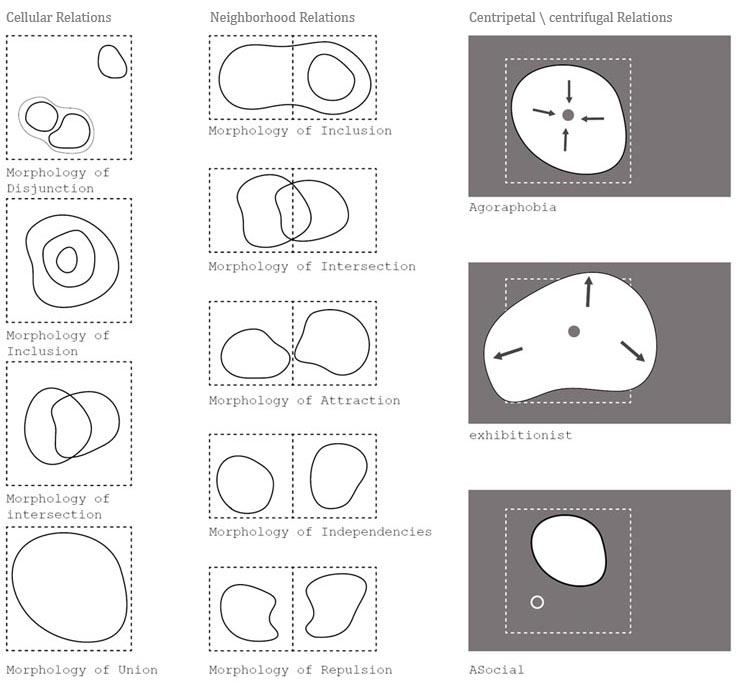
Cellular relations (possibility of three distinct zones)
If no family negotiation;
– Disjunction (morphology of separation)
If family negotiation;
– Inclusion (morphology of dependences)
– Intersection (morphology sharing zones)
– Union (morphology of panoptical space)
Neighbourhood relations (5 protocoles)
If no neighbourhood request;
– Independences (morphology of no specific requests)
If neighbourhood request;
– Repulsion (morphology of maximum distance)
– Attraction (morphology of rustling, of friction)
– Intersection (morphology of interlocking)
– Inclusion (morphology of dependences)
Transactional relation operations:
A certain number of axioms (nine) define the relationships between these sets.
The combination and equivalency of these operations makes it possible to define a multitude of relationships, both within the cell and immediately around it.
Schemas and formulations
An ensemble comprised of two residential cells subdivided into parts and subparts, making it possible to define their internal and external relationships simultaneously by means of the above axioms. This ensemble is exactly that, an ensemble.
Morphological definitions

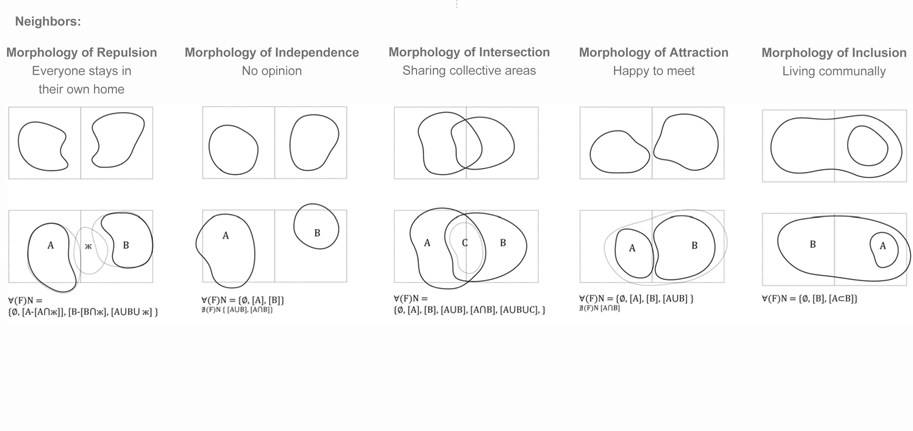
Morphological stratum
From mathematical equations to computational procedures.
Transformation of relational equations into parametric and computational algorithms (see script chaining) by means of a Vbnet script running on Rhino-Grasshopper software, so as to generate a 3-D volume.
Parametric Schemas
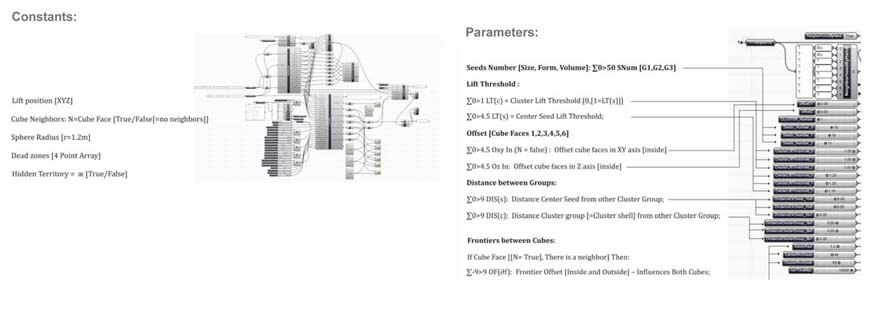
Values of correspondence / computation – mathematical formulations
Morphologies resultants [Cells]
Morphologies – variables & permutations
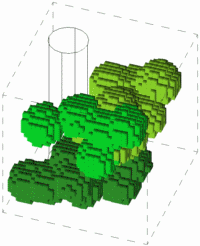 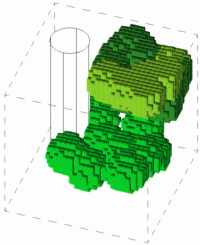 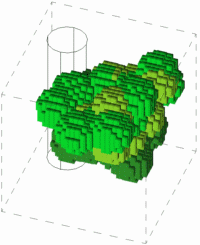 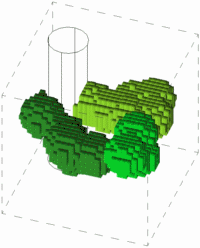
Morphologies resultants [Neighborhood]
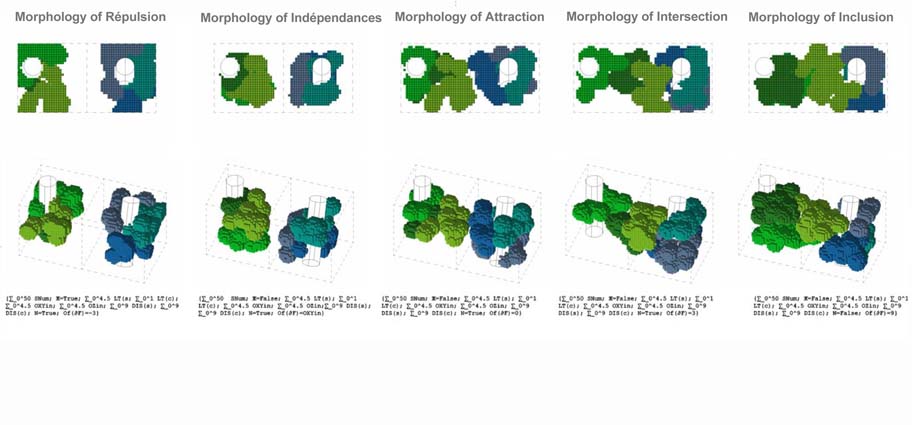 Morphologies – variables & permutations Morphologies – variables & permutationsList of physio collects methods
In general, there are many non-invasive technologies that have been around forever, such as these below:
- For centuries, physicians have employed many simple non-invasive methods based on physical parameters in order to assess body function in health and disease (physical examination and inspection), such as pulse-taking, the auscultation of heart sounds and lung sounds (using the stethoscope), temperature examination (using thermometers), respiratory examination, peripheral vascular examination, oral examination, abdominal examination, external percussion and palpation, blood pressure measurement (using the sphygmomanometer), change in body volumes (using plethysmograph), audiometry, eye examination and many others.
- The discovery of the first modern non-invasive techniques based on physical methods, electrocardiography and X-rays, dates back to the end of the 19th century. Since then, non-invasive methods – which penetrate the body nonetheless, but by electromagnetic or particle radiation rather than a scalpel – have continuously enlarged the scope of medical technology. Non-invasive techniques commonly used for diagnosis and therapy include the following:
Now, there are many more technologies, such as these general areas listed below:
Diagnostic imaging:
A recent advance is the substitution of invasive medical tests, such as colonoscopy by computer-based 3D reconstructions, such as virtual colonoscopy.
Diagnostic signals
Therapy
- Radiation therapy and radiosurgery, procedures that uses external atomic particles (protons, neutrons, photons, alpha particles, etc.) or gamma rays to destroy pathological tissue within the body
- Lithotripsy, a procedure that uses ultrasound shock waves to break urinary calculus
- Defibrillation, a procedure to block heart fibrillation and start normal rhythm
- Mechanical ventilation, such as the iron lung.
- Transdermal patches, used to deliver drugs applied to the skin.
- Biofeedback
- CPAP (Continuous Positive Airway Pressure) used to treat sleep apnea
- VPAP
- BIPAP
- Biphasic Cuirass Ventilation (BCV, eg. Hayek RTX)
- Photodynamic therapy
- Therapeutic ultrasound
- Extracorporeal thermal ablation
- Extracorporeal magnetic innervation [1]
- Photo-infrared pulsed bio-modulation [2]
- Transcranial magnetic stimulation
Comments are closed.
|







